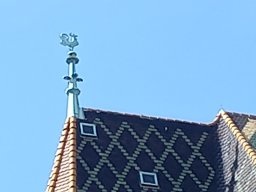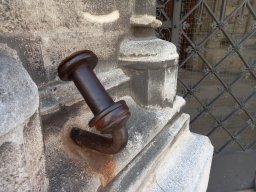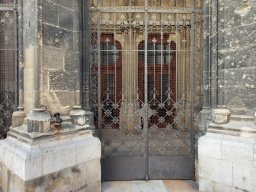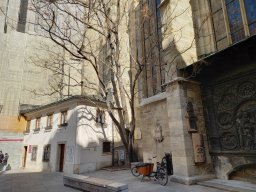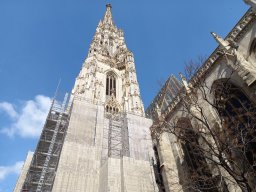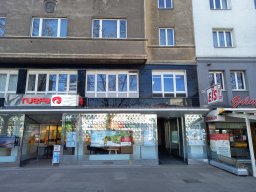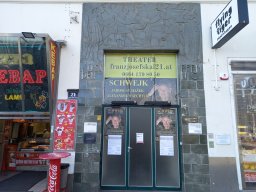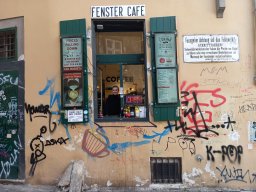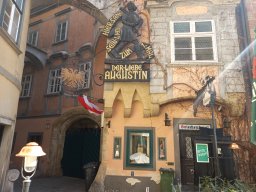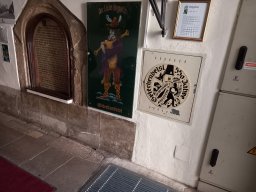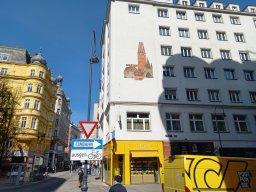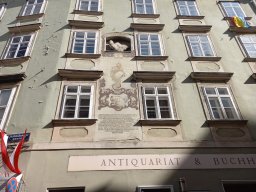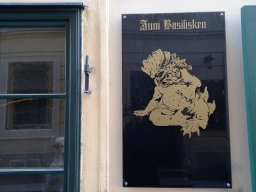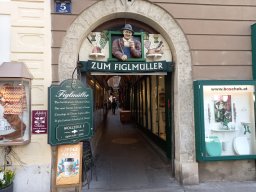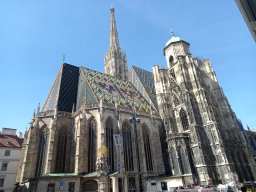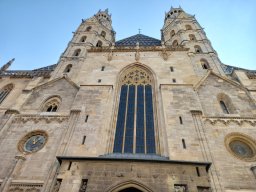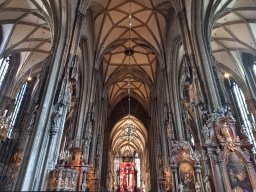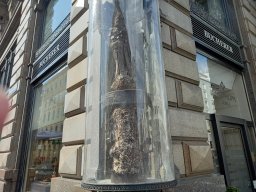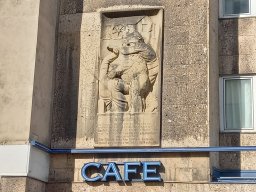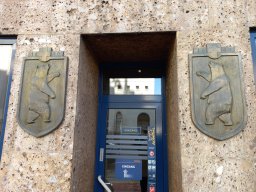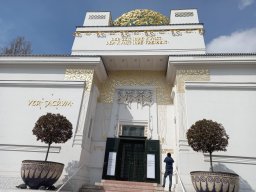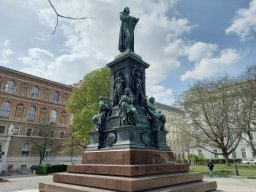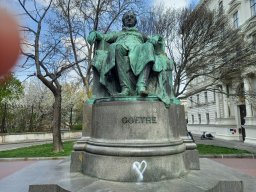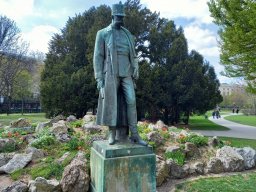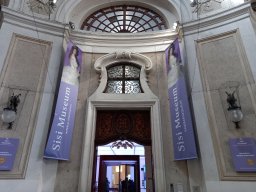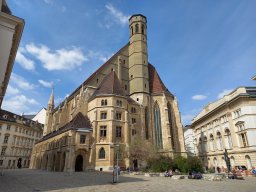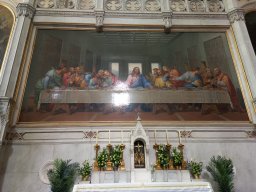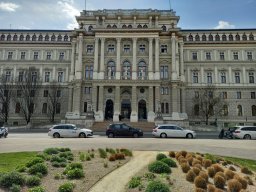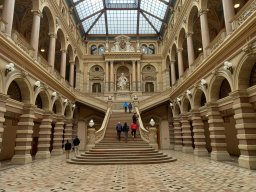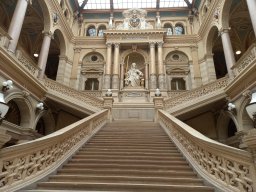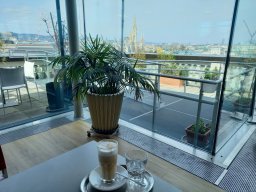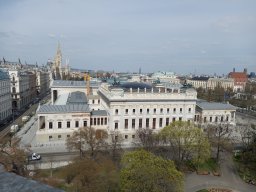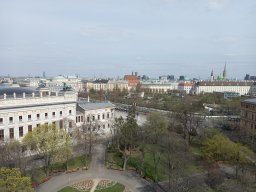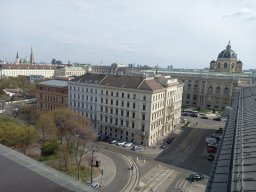An dieser Stelle möchten wir unsere tollen Kursteilnehmer*innen vor den Vorhang bitten.
Ein wunderbares Projekt, einer unserer Englischgruppen, umfasste die Erstellung einer Tour durch die Wiener Innenstadt zum Thema Sagen. Das Grundkonzept erstellte Gerhard Schmuckerschlag selbst und machte dann auch die passenden Fotos. Die Texte erarbeiteten die Teilnehmer*innen.
1) The wooden bacon in the Red Tower (by Gerhard Schmuckerschlag)
The Red Tower stood at the Schwedenplatz between Schwedenplatz 13 – 15. That is between Ruefa and the ice cream store Schwedenplatz. A picture of the Red Tower is on the house at Rotenturmstraße 23 / corner Fleischmarkt. (We will see it later).
The door of the Red Tower was an important point of the city of Vienna. Hundreds of horse-drawn wagons and walkers came here from the north into the city of Vienna.
Sometimes the traffic stopped at this point. When the people looked up under the door, they saw a wooden bacon hanging there over their heads.
On it there were written the following sentences:
"Is there any man here,
Who can speak out the truth,
That his marriage was not a mistake
and he is not afraid of his wife,
then this man should knock down this wooden bacon."
For many centuries, this wooden bacon was hanging in the Red Tower. None of the people passing by wanted to climb up and knock it down. It seemed that the men of Vienna were afraid of their wives.
But one day a man came to the Office of Vienna. He said that he was not afraid of his wife and so he wanted to knock down the wooden bacon. This shame for the men had to be removed. The city officials did not have anything against it.
Quickly everyone talked about that and so many people came to see it.
The man climbed up a ladder and wanted to remove the wooden bacon.
When the man saw the wooden bacon nearer, he turned around and climbed down the ladder again. He said to the people, " The wooden bacon is very dusty and dirty. I am dressed in my best clothes. They might get dirty from the wooden bacon. Then my wife at home would be very angry with me.”
First there was great silence, but then the people laughed out loud.
The brave hero turned around in shame and left without saying a word.
After that, the wooden bacon was still hanging over the door for many years. Nobody wanted to bring it down.
Only when the Red Tower fell, the wooden bacon with the sentences written on it also went away.
The husbands of Vienna were very happy about this.
2) Kiss the penny (Gerhard Schmuckerschlag)
Franz-Josefs-Kai 21 (back side = Griechengasse 3):
400 years ago exactly at this place there was the pub „Zum roten Adler“. The owner of this pub was Hans Wagler. Everyone in Vienna knowed that in this pub you could drink very good wine, eat very good things and could sleep in a very clean room. The pub-owner always loves to make more and more money and he loves it that the others are doing the work for him. His wife coocked very well, his son Josef worked in the wine cellar (= Weinkeller) and Marie was the waitress (= Kellnerin) and the chambermaid (= Zimmermädchen). Marie was a poor child with parents who had died years before. Marie was a very distant member of the very large Wangler family. So she was allowes to live in their house. Hans Wangler wanted to marry his son Josef to the beautiful and rich daughter of the owner of the pub "Zur grünen Weinrebe". But Josef wanted to marry Marie.
Hans Wangler was not happy about this. He told Marie to look for another job for the next month. Marie began to cry. She did not want to be separated from Josef. That same evening, she told her friend Josef about his father's plan. Josef was also thinking of leaving his father if he did not agree to his marriage with Marie.
The next evening, a new guest came into the pub very late. He had only a small old backpack and he looked poor. He sat down at a table and ordered good food, wine and a room for the night. The owner of the pub asked him if he could pay for this. "Pay?" the little man asked. "I am Mr. Paracelsus, the great doctor. That name should be enough for you. I came from Innsbruck to make the people of Vienna healthy. So give me food and a bed! I am hungry and tired."
The owner of the pub was very angry. But then Marie came in and said that she didn't want that the man had to sleep out on the street. She said she would pay for him with that little money she had. Hans Wangler was still not happy, but he agreed and the guest got what he had ordered.
After a few days, Paracelsus was still a guest at the pub. Hans Wangler began to get angry again and Marie was also worried because she saw that all her saved money would go away. Then Hans Wangler saw Maria in the arms of his son Joseph. Hans Wangler became more and more angry. He shouted that Marie had to leave the house immediately and that Josef should marry the rich daughter of the owner of the other pub. But Josef said that if Marie had to leave the house, he would go with her. No one could separate them.
When Hans Wangler heard this, he became more and more angry. Then Paracelsus came in and asked what was going on. Hans Wangler shouted at him: "You are the last one who has anything to say here, pay your bill now, otherwise you can go right along with the two of them!" Marie wanted to give Hans Wangler the money, but Paracelsus held her hand back. He searched in his vest pocket and found a little penny. This penny he gave to Hans Wangler, saying that this should be a small first payment. Angry about the little worthless penny, Hans Wangler shouted, "You call that a first payment? You are a liar and a cheater. You can no more turn this penny into gold than my son can get this girl for his wife!" With this words he threw the penny to the ground. Then Paracelsus looked to Hans Wangler and asked him, "Did you mean it? Do you keep this promise you have just made? If I turn the penny into gold, then Mary and Joseph are allowed to marry?"
"Yes, as long as I stand here and live!" said Hans Wangler. Paracelsus told him to pick up the penny and look at it more closely. Hans Wangler did it and saw that the penny had become to a glittering, heavy gold nugget. Paracelsus said: "I think my bill is paid with that! But now keep your promise and allow your son to marry Marie!"
Hans Wangler agreed and Marie und Josef was happy. Hans Wangler was standing there for a long time, looking at his nugget of gold. Over and over again he kissed it. The story of the magic changing of a penny into gold in the pub was spread quickly. So many people came into the pub to hear this unbelievable story. With so many guests, Hans Wangler made a big business and became rich more and more. As often as he took the gold nugget from its hiding place, he kissed it. And so the pub was getting the name "Küssdenpfennig".
Today, the pub in Adlergasse does not exist, but there is a sign above the door of the house that reminds us of this old story.
2a) Window Café (by Erzsebet Fabian)
This is a little coffeehouse in Vienna. Here you can buy the most expensive coffee in Vienna. For 10 Euro you get a coffee in a waffle. But the waffle must be very good because they sell a lot of this coffee.
3) The loveable Augustin (by Claudia Kunst)
More than 300 years ago there was a musician in Vienna called „Max Augustin“.
He created own songs and played the bagpipe. At this time a lot of people were not able to read or write so he told them all the interesting news from everywhere.
1697 the plague came back to Vienna. Thousands of citizens left Vienna, thousands died. But the loveable Augustin stayed in Vienna and one evening he drank a lot of beer and wine. On his way home from „Stubentor“ to his apartment in the third district he fell into a plague pit because he was so drunk. He slept there the whole night among dead people.
When he woke up he was not able to climb out of the pit. So he screamed loudly and people who heard him helped him out. The strangest thing was that he was not infected by the plague. He never had the plague.
After his accident Augustin wrote a song about his adventure which everyone knows: „Oh, du lieber Augustin“
Due to this story the loveable Augustin is the Viennese symbol that you can survive everything with alcohol.
At the entry of the „Griechenbeisl“ (opened every day from 12 pm) you can see a hole in the floor with an Augustin figure.
4) The Basilisk (by Beata Salomon)
The Basilisk is a very ugly animal. It is very stinky and a hybrid of a rooster, a snake and a toad. One day a baker finds this funny animal and can kill it by holding a mirror in front of the basilisk. The basilisk is so shocked by his own ugliness that it drops dead straight away.
5) The rooster on the roof of St. Stephans (by Beata Salomon)
I will now tell you about the rooster which is located on the church of St. Stephans. A long time ago there lived a nobleman in Vienna. His name was Kaspar Schelzer. He was very happy with his wife but a friend of the duke fell also in love with her. That is the reason the duke sent Kasper under a pretext to Turkey.
Kaspar says his wife to only marry again if he was certainly dead. This is the case if she gets back his silver cross. In Turkey he was imprisoned and stayed there for many years. Then - one night - he had a nightmare: He sees his wife marrying another man on the very next day.
The man woke up and cried: Oh my God, tomorrow my wife will marry another man. If I could be in Vienna by tomorrow I would give my soul for it. Suddenly a rooster cried and an evil spirit and the bird stood in front of his bed. The evil spirit said: Very well. If my rooster takes you to Vienna tonight, then your body and soul will be mine. Kaspar agreed but only if he would not wake up once during the journey. He said: If I wake up you get nothing.
He kept his silver cross and prayed to god. On the way to Vienna as they were almost by St. Stephens the sun rose. And because of this the rooster cried out loud. And so the man woke up before they arrived at their destination. The evil spirit had lost the game.
Happy end for Kaspar and his wife. In memory of this adventure Kaspar ordered a replica of the rooster. This is the golden rooster you can see on the roof of St. Stephens.
6) The linden tree of St. Stephens (by Andrea Lombardo)
Long time ago, as the magnificent Stephansdom in Vienna was still a small church, the pastor at that time had a linden tree planted. The pastor was very happy because the tree grew very well.
The city grew and the cemetery soon became too small. That is the reason why they wanted to chop down the linden tree. But the pastor loved his tree and so it was allowed to stay. The tree was beautiful and that made the pastor very happy. Many years later when the pastor was very old he wished to see his beloved tree blossom again.
He was very ill and because it was winter his tree had no blooms. He layed in the bed and asked someone to open the window. When the pastor looked out of the window the sky was blue and the linden tree was full of blossoms. The warm wind blew a few of them into the room and the pastor was happy and he died in peace. When the people in the room looked outside the window again it was the dead of winter and the tree was not in bloom. They were all without words about these miracles and fell on their knees.
7) The bowler of St. Stephens (by Claudia Birkner)
In the tower of the church was a very little bowling alley. It was a very small room and that is the reason why everybody had to turn back to roll the ball.
At that time there lived a man called Meister Kunrat in Vienna. He was a very good bowler and he was able to get all of the pins with one shot. But he was a very hard drinker. One night he was thrown out of the pub and so he had no possibility to bowl in that pub.
He walked through the streets of Vienna. Suddenly he was in front of the St. Stephens cathedral. He went up the stairs to the bowling alley and took a ball. At this moment he recognized a man with a long grey coat staring at him.
Meister Kunrat cried: Why are you looking at me? Go away! Or do you want to play with me?
But secretly thinking: I am the best bowler!
He continued: I always get all nine pins with one shot.
The foreigner said that he was able to do so as well. Meister Kunrath took a ball and shot it: all nine pins. Strike.
He laughed: So now you have to do it like me!
He took a pin in an unnoticed moment and threw it out of the window. In this very moment the stranger turned into a huge creature. He said to Meister Kunrat: This is not the way we have bet. I am Death and I always get all nine pins although there are only eight.
Then Death took a ball and stroked all the pins. The eight of the bowling alley and as the ninth pin Meister Kunrat dropped dead to the ground. He was found the next day by the tower guard.
This is the reason why everybody who visited the bowling alley in the tower had to pray a Vaterunser for the poor soul of Meister Kunrat.
8) The bear mill (by Claudia Birkner)
At the time when there were still very few houses in the district of Wieden there were hungry wolves and also bears in the winter.
The inhabitants were very afraid of these animals. The legend of the bear mill tells us that a big black bear attacked the owner of the mill. The miller cried for help. The millers' boy was upstairs at this moment. He opened the window to look at what was going on. Without hesitating the boy jumped out of the window on the bear's back. He put his arms around the bear's neck and fought against the animal.
The miller took advantage of the opportunity to crawl out under the bear. Other people quickly rushed over to kill the creature.
The miller thanked his strong brave boy and wanted to give him money as an award. But the boy asked only for the bear's skin out of which he made himself a fur and wore it all his life.
The miller had a picture made showing the bear. He hung it above the entrance of the mill. So the mill was called the “Bear Mill”.
8a) Secession (by Erzsebet Fabian)
This is a museum and it is one of the most important buildings representing the Jugenstil. Famous artists are Klimt and Schiele.
8b) Schiller Monument (by Erzsebet Fabian)
The monument of the famous German poet Friedrich Schiller is located in the Schillerpark. He lived from 1759 to 1805. He became friends with the equally famous German poet Goethe. The monument was set up in 1876.
The most famous works by Schiller are his plays Wilhelm Tell, Kabale und Liebe and Die Räuber.
8c) Memorial of Goethe (by Erzsebet Fabian)
This monument stands at the Opernring. Johann Wolfgang Goethe lived from 1749 to 1832. He was 10 years older than Schiller. The monument was set up in 1900. 24 years after Schiller's monument. Famous plays of Goethe are Faust, Die Glocke and Die Leiden des jungen Werther.
8d) Hofburg – Sisi Museum (by Claudia Kunst)
1854 Elisabeth, called „Sisi“ married the emperor Kaiser Franz Joseph. That is why she became empress of Austria. 1867 she became also queen of Hungary.
In winter Franz and Sisi lived in Vienna in the „Hofburg“ and in summer in „Schloss Schönbrunn“. In the „Hofburg“ you can visit the huge apartment of them.
Sisi was murdered 1898 in Geneva. Franz Joseph died 1916.
8e) Minorite Church (by Gerhard Schmuckerschlag)
The Minorite Church was built between 1230 and 1350. It stood just behind the city wall.
The tower of the church was higher than the city wall and it was used as a watchtower.
In 1529 the Turks stood in front of the city wall of Vienna for the first time. The Turks shot down the top of the tower of the Minorite Church.
After the Turks lost the battle with Vienna, the people of Vienna built the top of the tower of the church again.
In 1683 the Turks stood in front of the city wall of Vienna for the second time. Also in this year they shot down the top of the tower of the Minorite Church.
After the Turks lost the battle again, the people of Vienna built only a small roof on the top of the tower so that the rain could not fall into the church.
The people of Vienna wanted to rebuild the tower top, but they haven't done it until today. So this is probably the longest standing provisional structure that can be seen in Vienna.
The Minorite Church is the centre of the religious people in Vienna who were born in Italy.
8f) Minorite Church - The Last Supper (by Andrea Lombardo)
This is an exact copy of Leonardo da Vinci's The Last Supper. The original mosaic dates 1495 and can be seen in Milano, Italy. In 1809 Napoleon commissioned the artist Giacomo Raffaelli to make a copy and bring it to Paris. Each stone is only a few millimetres in size and Raffaelli built them together without any gaps.
After the work was done Napoleon was no longer an emperor and he never saw this masterpiece. That is why emperor Franz I bought the almost 20 ton heavy mosaic and had it shipped to Vienna. However this copy is more beautiful than the original in Milano because the colours of the original began to fade already at the beginning of the 16th century.
8g) Palace of Justice and Justice Coffee Shop (by Gerhard Schmuckerschlag)
The Palace of Justice stands on the left side of the Parliament. It was built from 1875 to 1881.
The Palace of Justice is the seat of the Supreme Court of Austria.
In front of the entry there are 2 big stone lions. Inside, in the centre of the Palace of Justice, there is the marble statue of the Roman goddess Justitia with a golden sword and the book of laws.
In 1927, after the court decision of the Schattendorf process, there were wild demonstrations. People stormed the Palace of Justice and set it on fire. In the fighting between demonstrators and the police, 84 demonstrators and 5 policemen were killed.
Until 1931 the Palace of Justice was rebuilt.
In 2007, the restaurant and the coffee shop on the Palace of Justice was opened. Anyone can go there. But it is only open from Monday to Friday and it always closes at 4 pm on these days. You can pay only with cash.


